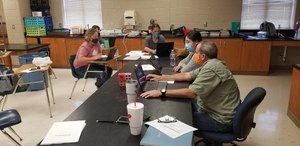
There are really no good options for returning to school this fall, but these resources may be able to help with much-needed funding
“Stuck between a rock and a hard place” is the idiom that comes to mind when thinking about schools reopening in a pandemic.
Per Grammarist.com , this turn of phrase originated “in the early 1900s to describe a dispute between copper miners and the mining companies in Bisbee, Arizona.” The miners needed safer working conditions, but their companies disagreed, leaving them to choose between continuing to work in deplorable conditions (a rock) or losing their jobs and income (a hard place).
Likewise, schools and families face a difficult dilemma this fall: opening schools with the possibility of widespread COVID-19 outbreaks and more closures (a rock) or sticking to remote learning, which is not the best learning environment for all students, not to mention a hardship for parents needing childcare to be able to work remotely or otherwise (a hard place).
As the grandparent of a grandson preparing to start school this fall, I can definitively say this a travesty for all of us: choosing between health and safety for students/teachers/families (a rock) or education (a hard place).
So, what are the reopening guidelines for schools? Since there is no precedent, schools must ultimately fend for themselves, though some guidance has been provided by the Centers for Disease Control and Prevention, departments of education, and departments of health. You can also check out any website of a school or school district in your community to find information about their planning for this fall.
When writing COVID-19 related education grants, these are good places to review when talking about the need and project plans in each school community. Be prepared to discuss how COVID-19 has impacted your school finances, staffing, organizational capacity, and available funding (or lack thereof).
The CDC provides guidelines for schools, including lowest risk, more risk, and highest risk considerations.
The World Health Organization imparts guidance for schools.
PureWow posted an interesting article going through the ABCs of What Will School Look Like in September?
An USA Today/Ipsos survey showed that when schools reopen in 2020, approximately a third of parents will pursue distance learning for their children and one in five teachers may not return to the classroom.
The Center on Reinventing Public Education (CRPE) at the University of Washington Bothell has a free archived webinar through EdSource, To the Extent Feasible: Strategies for Success with Distance Learning . (Here is the slide deck PDF.) CRPE analyzed how 82 school districts and 18 charter schools moved to distance learning.
Impact Public Schools produced a presentation about distance learning and elementary school social-emotional learning (EdSource).
A YouTube channel created by two teachers, All of the Above: An Unstandardized Take on Education , has episodes such as THAT was a wild school year! Now what ? and What will schools look like this fall?? - An AOTA Special .
The U.S. Census Bureau Quick Facts website lays out valuable information by state, county, city, town, or zip code, including population estimates, age, sex, housing data, race, computer/internet use, education, and the economy.
Data USA issues so much helpful information such as adult obesity by county, opioid deaths by county, analysis of cities/places, industries, jobs, universities, degrees, current stories, adult smoking by state, average wage for jobs, federal agency spending by state, median property value, number of employees, and so much more.
Feeding America imparts data on food insecurity in each county and congressional district in the USA.
Mona Foundation is “a global community of individuals and organizations who believe that the key to alleviating poverty and achieving sustained community transformation lies in education and gender equality.” Beside furnishing grant funding for education, this foundation supplies data concerning literacy, persistent global poverty, the gender gap, and the skills gap.
The National Low Income Housing Coalition dispenses fantastic data, including about how much an individual needs to earn in order to afford a place to live. Their “ Out of Reach 2020 ” report is currently available. Enter a zip code to find current housing data in any community. The interactive map provides by zip code the following information: one- or two-bedroom housing hourly wages needed, fair market rents, poverty rate, median household income, labor force participation, unemployment rate, and ethnicity/race percentages.
What are your favorite data goldmines as we struggle to escape this rock and a hard place we find ourselves in?
Copyright © 2025 EducationGrantsHelp.com. All rights reserved.
